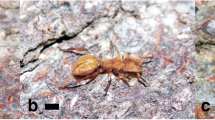Abstract.
By regulating both the choice between solitary or collective retrieval and the level of nestmate investment for heavy prey transport, individual hunters of the ant Gnamptogenys sulcata are able to increase the foraging efficiency of the whole society, despite the extremely small size of this elite group (1 –4 hunters per colony). Their predatory behavior changes according to the static (weight, size, shape) and dynamic (mobility, escape behaviors) characteristics of the prey. The behavioral sequences resemble those of other poneromorph ants, but palpation after the approach phase is absent, probably because of the swiftness of the attack. Hunting is always performed by solitary workers but, independently of prey type and mobility, small, light prey trigger solitary retrieval whereas large, heavy prey trigger collective retrieval. For intermediate prey weights (8.5 to 21 times the hunter’s weight), some variability in the strategy choice is encountered. Both static and dynamic factors are involved in assessing the difficulty of handling living prey as shown by the number of stings delivered by the hunter for prey immobilization. However, the lack of any stinging against already dead prey indicates that these factors must be uncoupled when selecting retrieval strategies. Prey weight has a major role in this choice. For a given prey size always triggering solitary retrieval, a two-fold increase in prey weight is sufficient to trigger collective transport. Conversely, for a given prey size always triggering collective retrieval, a decrease in prey weight can trigger solitary transport. Moreover, presenting hunters with prey of “infinite” weight triggers several waves of recruitment, so that the number of recruited workers compensates for the “apparent” prey weight. Despite the inability to finely match the number of recruits to the weight of retrieved prey, recruitment strategies adopted by G. sulcata may reflect an evolutionary primitive step towards the finely graded recruitment behavior observed in closely related poneromorph species.
Similar content being viewed by others
Author information
Authors and Affiliations
Corresponding author
Additional information
Received 5 February 2007; revised 25 May 2007; accepted 15 June 2007.
Rights and permissions
About this article
Cite this article
Daly-Schveitzer, S., Beugnon, G. & Lachaud, JP. Prey weight and overwhelming difficulty impact the choice of retrieval strategy in the Neotropical ant Gnamptogenys sulcata (F. Smith). Insect. Soc. 54, 319–328 (2007). https://doi.org/10.1007/s00040-007-0949-2
Published:
Issue Date:
DOI: https://doi.org/10.1007/s00040-007-0949-2




